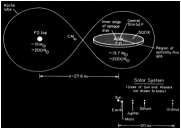

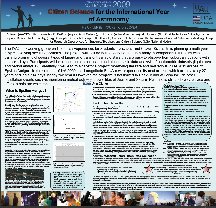

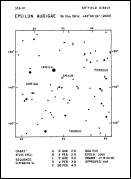
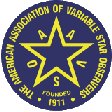
Epsilon Aurigae Eclipse: 2009 - 2011
The epsilon Aurigae eclipse is intriguing because of the long period between eclipses ( 27 years ), the length of the eclipse ( 21 months ) and the nature of the eclipse. The length of the eclipse means that the drop in magnitude cannot be caused by an eclipse of another star. The star would be far too big- there is no known star that would be big enough to extend out to the orbit of Neptune if it was in the solar system. Epsilon Aurigae itself extends out to the orbit of the Earth. As a star is ruled out it is thought that the eclipse represents the covering of epsilon Aurigae by a large cloud of dust and gas. One of the purposes of calling for intensive observations over the next two years is confirm the existence of the cloud. Wikipedia now contains useful background information on the system.
The nature of the eclipse explains the importance of visual observations. Experts do not expect the cloud of dust and gas to be regularly shaped. It may not be one mass. It may be of uneven density. For these reasons the expected drop in magnitude from 3 to 3.7 may not be smooth. There could be fluctuations which will be of large enough dimensions for visual observers to pick up. There may be fluctuations before the eclipse as epsilon Aurigae is obscured by subsidiary clouds. Visual observations may be crucial in mapping these detailed changes as vagaries of the weather may prevent instrumental observations for days. Recently there were no instrumental observations of epsilon Aur in the USA for a week due to cloud. A fortunate visual observer may be in the right spot to provide the only estimates for some time.
New Chart
The BAAVSS has produced a new chart for observers (see link above).
It is suggested that between now and the middle of May observers practice on making estimations of epsilon Aurigae using the chart. The magnitude should be around 3.0. There are brightness fluctuations outside of eclipse due to pulsations of the primary star. It is therefore possible that estimates of between 2.9 and 3.1 may be recorded.
From the middle of May to the beginning of July observers in the UK will find it difficult to make reliable observations because the star will be too close to the sun. Reliable observations will not be possible when the star is within 20 degrees of the horizon. This is because atmospheric turbulence will cause rapid and confusing changes in brightness. In addition the magnitude differences between epsilon and its comparisons are not reliable when seen through the thick atmosphere below 20 degrees.
From the middle of July observations will be possible before dawn. We would urge observers to make a special effort to carry out early observations in the month up the expected start of the eclipse on 6th August. This is because the eclipse may start earlier than predicted and because there may be, as mentioned earlier, subsidiary clouds of dust and gas that cause brightness fluctuations detectable by visual observers.
The Fade to December 2009
Once the eclipse starts ( and it may be late ) there will be a fade until totality which is scheduled around December 21st. Actually totality is a misleading term in the context of the eclipse of this star. The star is not totally obscured. Its light is reduced by about 200% by the thick cloud.
If the fade was smooth then it probably would only be necessary to observe once a week. If there are fluctuations, more frequent observations may be useful. In any case all observations will be welcomed so that there is the best possible record of the eclipse.
We hope to be able to create a monthly report of all observations. All observations will be credited to individual observers.
“Totality” is predicted to last until March 12 2011. In the middle there is a possibility that there might be a mid eclipse brightening that could be picked up visually. It is thought that there may be a gap in the cloud which reveals another star, contained within the cloud, which is orbiting epsilon.

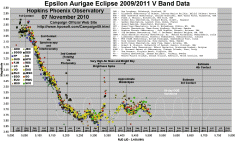

PREDICTED CALENDAR OF ECLIPSE EVENTS:
2009 Aug 6th - predicted start of eclipse, rising with sun as a morning star
2009 Nov/Dec - eps Aur transits at midnight --> evening star
2009 Dec 21 - predicted start of totality, evening star
2010 May - eps Aur setting with the sun, mid eclipse brightening?
2010 Aug 1st - predicted time of mid-eclipse, early morning star
2010 autumn - end of mid-eclipse brightening?
2010 Nov/Dec - eps Aur transits at midnight --> evening star
2011 March 12 - predicted end of totality, evening star
2011 May 15 - predicted end of eclipse, next one starts in 2036.
INSTRUMENTAL ESTIMATES
Instrumental estimates are welcomed as the increased accuracy will allow more detailed effects to be picked. CCD and DSLR will reveal the pulsations of epsilon Aurigae itself. These have an amplitude that seems to vary between 0.1 magnitude and 0.16 magnitude with a period of about a hundred days. Instrumental estimates may also provide more detail on the dimensions of the dust/ gas cloud.
Good estimates can be made with a DSLR. The settings with Canon 350D DSLR and 85 mm lens are ISO 200, f4.5 and an exposure of 5 seconds. 20 images form one set to be analysed with AIP4WIN.
The international instrumental campaign started in October 2008. Most of the time epsilon Aurigae has been around 2.99V but has dipped to minima at 3.06V and 3.14V in March 2009
June 1st 2009, Des Loughney
Following its March/ April fade epsilon brightened to around
2.87V at the beginning of May.
Observations have been difficult in May, particularly after the middle of May,
because the system is so low down ( under 20 degrees).
From the observations of the members of the International Campaign it seems that
epsilon slowly declined during May to its usual
brightness around magnitude 3 by the end of the month.
Despite the difficulties we will continue to monitor the system ( which is
circumpolar at the latitude of Edinburgh ) throughout June.
September 12th, 2009
It seems that the eclipse has started as the magnitude is now
below the normal out of eclipse variation. If it is the eclipse
fade then the shape of the recent light curve suggests that the fade started
around the middle of August which is only about a week later than predicted.
The prediction was quite accurate given the long period ( 27.1 years ) of
the system. For visual observers it should soon become apparent that
epsilon has dropped from its usual magnitude of around 3.
August 23rd 2009
The eclipse was predicted to start on 8th August. At the time
of writing there has been no indication that the eclipse has started in
visible wavelengths. Over the last five weeks epsilon has hovered around
magnitude 3.01. There have been occasional brightenings. For example it
brightened to around 2.93 on 22/7/09.
A late start to the eclipse was always a possibility given the nature of the
eclipsing body which is thought to be a cloud of dust and gas. It is always
difficult to precisely predict the start of an eclipse with a 27 year
period.
Epsilon is, at the time of writing, in a good position for observation at
around 2 am BST.'
Des Loughney
EB Secretary
desloughney [at] blueyonder.co.uk
Broadly speaking epsilon Aurigae has continued to fade
as the updated light curve illustrates at the top of the page. There has
been however some sort of shoulder in the light curve or change in the rate
of decline. This is mirrored in the spectroscopic data. It is not known what
is the cause of this change. It may be variations in the density of the
cloud of gas and dust that is eclipsing epsilon or the variations of epsilon
itself. The change in the light curve may mean that ' totality' occurs later
than the predicted third week in December. It may not now occur until the
New Year.'
October 18th 2009
The eclipse is now well
underway. Epsilon is about half way to minimum which should be reached in
late December. There has been some discussion regarding the start of the
eclipse. It has been difficult to establish the exact start because epsilon
is a variable star itself. The predicted start was the 6th August. Some
experts consider that the eclipse started on 19th
August and others on 27th August. Either way the start was a bit late. By
start of eclipse we mean the start visually or relative to V filters.
Robin Leadbeater detected the spectroscopic start at around the 20th July
when a spectroscopic signature of the eclipsing cloud developed.
Epsilon Aurigae has continued to fade from the middle of November 2009. By the 23rd December it had reached about 3.67V. It had been predicted that it would continue to fade until the system reached a magnitude of perhaps 3.83. Since the 23rd December it has hovered between 3.66 and 3.69. It may have reached totality. A further fade is possible so observations are still welcome. Variations in the obscuring dust and gas cloud are of interest so observations should continue so that these can be picked up. Have a look at the Astronomy Picture of the Day for 8/1/10 at http://apod.nasa.gov/apod/ap100108.html
It is now thought that Epsilon reached ' totality' on
16/1/10 at around 3.7 V magnitude. This signifies that epsilon is obscured
to the maximum extent by the cloud of dust and gas ( see the artists
impressions of the system at the top of the page).
Epsilon continues to slowly fade over the past month. At the time of writing
it is around 3.75V and still apparently dropping. The further fade is
probably due the intrinsic variability of the star itself - it can vary
through up to 0.15 magnitude.
25th April 2010
Epsilon Aurigae has continued in its ' totality' phase with a magnitude of around 3.77. There was an increase to 3.71 in March followed by a fade back to 3.77 which it is at currently. The brightening in March is thought to be part of the intrinsic variation of epsilon itself. The accepted model of the system predict a brightening around the centre of the eclipse to about 3.60 magnitude. Picking up this increase is the next target in the campaign. However, observations will be difficult from the middle of May until the middle of July as epsilon will be low down and in the twilight ( from the UK) Corrections for atmospheric extinction can be made so it is hoped that instrumental observations will continue over the summer.